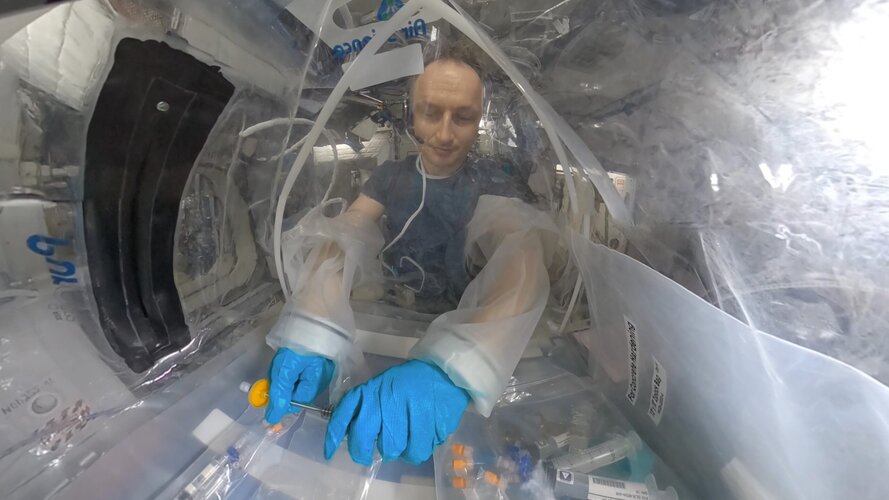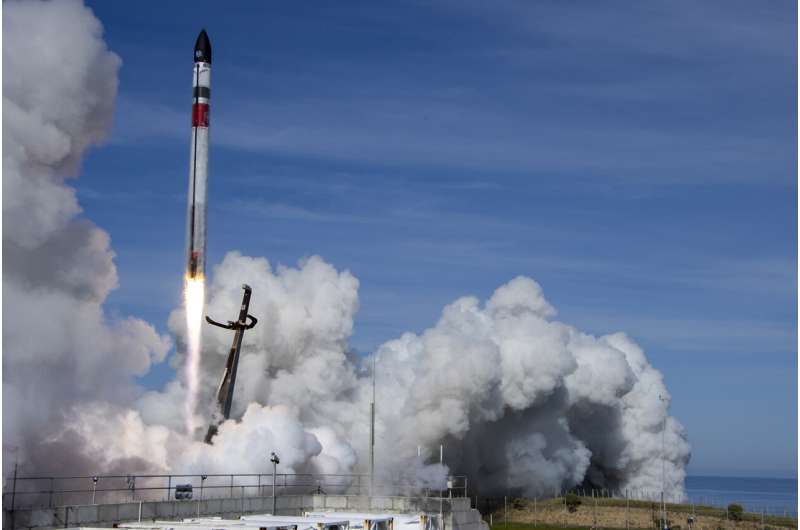Multi-energy electron device creates space environment in the lab
Tuesday, 03 May 2022 08:37 Scientists and engineers from the Air Force Research Laboratory are developing a multi-energy electron source, capable of emitting a beam of electrons, at dozens of energies simultaneously.
In a project funded by the Department of Defense, the multi-energy electron device was invented by Dr. Miles Bengtson during his tenure as a graduate student at the University of Colorado Boulder. Follo
Scientists and engineers from the Air Force Research Laboratory are developing a multi-energy electron source, capable of emitting a beam of electrons, at dozens of energies simultaneously.
In a project funded by the Department of Defense, the multi-energy electron device was invented by Dr. Miles Bengtson during his tenure as a graduate student at the University of Colorado Boulder. Follo SSi Canada contracts SES to meet Canadian Government broadband goals
Tuesday, 03 May 2022 08:37 Consumers, students, government entities and businesses across Northern Canada, including all 25 communities of Nunavut, will have access to expanded broadband capacity following a partnership signed between SSi Canada, the developer-operator of QINIQ broadband and SSi Mobile services in Nunavut, and SES, the leader in global content connectivity solutions.
Under the agreement, SES will pr
Consumers, students, government entities and businesses across Northern Canada, including all 25 communities of Nunavut, will have access to expanded broadband capacity following a partnership signed between SSi Canada, the developer-operator of QINIQ broadband and SSi Mobile services in Nunavut, and SES, the leader in global content connectivity solutions.
Under the agreement, SES will pr Call for Media: Join ESA’s Living Planet Symposium in Bonn
Tuesday, 03 May 2022 08:30
Call for Media: Join ESA’s Living Planet Symposium in Bonn
Concrete Hardening | Cosmic Kiss 360°
Tuesday, 03 May 2022 08:03 Video:
00:02:47
Video:
00:02:47
Take a look inside the box and join ESA astronaut Matthias Maurer from a very special perspective as he supports the @DLR Mason/Concrete Hardening experiment.
The Concrete Hardening experiment investigates the behaviour of various concrete mixtures containing cement and sand or simulated ‘Moon dust’ combined with water and various admixtures. On Earth, higher density components tend to move downward but in weightlessness they are likely to be more evenly distributed.
Researchers will analyse the concrete mixed by Matthias in space for strength, bubble and pore distribution as well as crystal structures, comparing this to ground samples. Their findings will
New Zealand rocket caught but then dropped by helicopter
Tuesday, 03 May 2022 07:06
Using a helicopter to catch a falling rocket is such a complex task that Peter Beck likens it to a "supersonic ballet.
Rocket Lab catches rocket booster returning from space with helicopter
Tuesday, 03 May 2022 04:10 Rocket Lab (Nasdaq: RKLB) has successfully launched its 26th Electron mission, deploying 34 satellites to orbit. Rocket Lab has now deployed a total of 146 satellites to orbit with the Electron launch vehicle.
The "There And Back Again" mission also saw Rocket Lab complete a mid-air capture of the Electron booster with a helicopter for the first time. After launching to space, Electron's first
Rocket Lab (Nasdaq: RKLB) has successfully launched its 26th Electron mission, deploying 34 satellites to orbit. Rocket Lab has now deployed a total of 146 satellites to orbit with the Electron launch vehicle.
The "There And Back Again" mission also saw Rocket Lab complete a mid-air capture of the Electron booster with a helicopter for the first time. After launching to space, Electron's first New standard will aid in classification of commercial spaceflight safety events
Tuesday, 03 May 2022 04:10 ASTM's commercial spaceflight committee (F47) has approved a new standard that will help to enhance commercial spaceflight safety. The standard (F3550) provides guidance to space flight operators on classifying safety-related events.
"This new standard will help to classify events based on severity and impact," says ASTM International member Oscar Garcia, chairman and CEO, InterFlight Glob
ASTM's commercial spaceflight committee (F47) has approved a new standard that will help to enhance commercial spaceflight safety. The standard (F3550) provides guidance to space flight operators on classifying safety-related events.
"This new standard will help to classify events based on severity and impact," says ASTM International member Oscar Garcia, chairman and CEO, InterFlight Glob Successful test launch a giant leap for rocketry team
Tuesday, 03 May 2022 04:10 Students of the University of Sydney's rocketry society, the USYD Rocketry Team, have their eyes firmly set on gold after successfully launching their 2022 competition rocket in New South Wales's far west.
After a two-year pandemic hiatus, the team will fly to the US in June to compete at Spaceport America Cup, an international student rocketry competition held annually in New Mexico.
Students of the University of Sydney's rocketry society, the USYD Rocketry Team, have their eyes firmly set on gold after successfully launching their 2022 competition rocket in New South Wales's far west.
After a two-year pandemic hiatus, the team will fly to the US in June to compete at Spaceport America Cup, an international student rocketry competition held annually in New Mexico. British rocket company calls for Iceland to grant licence for landmark launch
Tuesday, 03 May 2022 04:10 British rocket company Skyrora has called on the Icelandic government to grant the licence that would end a months-long delay to Europe's largest-ever suborbital rocket launch, originally set for September 2021. With the launch from Husavik, Iceland - for which it built Europe's largest mobile spaceport - Skyrora had been ready to take a crucial next step towards its goal of completing the first
British rocket company Skyrora has called on the Icelandic government to grant the licence that would end a months-long delay to Europe's largest-ever suborbital rocket launch, originally set for September 2021. With the launch from Husavik, Iceland - for which it built Europe's largest mobile spaceport - Skyrora had been ready to take a crucial next step towards its goal of completing the first NASA's new solar sail system to be tested on-board NanoAvionics satellite bus
Tuesday, 03 May 2022 04:10 NanoAvionics has been selected to build a 12U nanosatellite bus for an in-orbit demonstration of NASA's Advanced Composite Solar Sail System (ACS3). This a result of a contract between NASA Ames Research Center and AST for a 12U bus to carry NASA's payload into low Earth orbit (LEO) including an approximately 800 square foot (74 square meter) composite boom and solar sail system.
The aim
NanoAvionics has been selected to build a 12U nanosatellite bus for an in-orbit demonstration of NASA's Advanced Composite Solar Sail System (ACS3). This a result of a contract between NASA Ames Research Center and AST for a 12U bus to carry NASA's payload into low Earth orbit (LEO) including an approximately 800 square foot (74 square meter) composite boom and solar sail system.
The aim Farewell to the Torridon Quad - Sols 3459-3461
Tuesday, 03 May 2022 04:10 We have left the pediment behind and are making our way back to an alternate "MSAR" or "Mount Sharp Ascent Route." We are at the second (of three) observation stops for this area, chosen as they offer the best chance to acquire high resolution images of the structures in the buttes. We have noticed some dark layers which are reminiscent of the lenses at "The Prow" and may indicate changing grain
We have left the pediment behind and are making our way back to an alternate "MSAR" or "Mount Sharp Ascent Route." We are at the second (of three) observation stops for this area, chosen as they offer the best chance to acquire high resolution images of the structures in the buttes. We have noticed some dark layers which are reminiscent of the lenses at "The Prow" and may indicate changing grain Emirates Mars mission discovers new mysterious aurora
Tuesday, 03 May 2022 04:10 The Emirates Mars Mission, the first interplanetary exploration undertaken by an Arab nation, today released stunning images of Mars' enigmatic discrete auroras, following a series of revolutionary observations that promise new answers - and new questions - about the interactions between Mars' atmosphere, the planet's magnetic fields and the solar wind.
The observations include a never-bef
The Emirates Mars Mission, the first interplanetary exploration undertaken by an Arab nation, today released stunning images of Mars' enigmatic discrete auroras, following a series of revolutionary observations that promise new answers - and new questions - about the interactions between Mars' atmosphere, the planet's magnetic fields and the solar wind.
The observations include a never-bef China's Zhurong travels over 1.9 km on Mars
Tuesday, 03 May 2022 04:10 The Mars rover Zhurong has traveled more than 1.9 km since it first set its wheels on the surface of the planet in May last year, according to the latest data released by the Lunar Exploration and Space Program Center of the China National Space Administration.
As of Sunday, Zhurong had been operating on the surface of Mars for 342 Martian days at a distance of 240 million km from Earth. A
The Mars rover Zhurong has traveled more than 1.9 km since it first set its wheels on the surface of the planet in May last year, according to the latest data released by the Lunar Exploration and Space Program Center of the China National Space Administration.
As of Sunday, Zhurong had been operating on the surface of Mars for 342 Martian days at a distance of 240 million km from Earth. A Search reveals eight new sources of black hole echoes
Tuesday, 03 May 2022 04:10 Scattered across our Milky Way galaxy are tens of millions of black holes - immensely strong gravitational wells of spacetime, from which infalling matter, and even light, can never escape. Black holes are dark by definition, except on the rare occasions when they feed. As a black hole pulls in gas and dust from an orbiting star, it can give off spectacular bursts of X-ray light that bounce and
Scattered across our Milky Way galaxy are tens of millions of black holes - immensely strong gravitational wells of spacetime, from which infalling matter, and even light, can never escape. Black holes are dark by definition, except on the rare occasions when they feed. As a black hole pulls in gas and dust from an orbiting star, it can give off spectacular bursts of X-ray light that bounce and QuantX Labs and SmartSat CRC accelerate the development of an orbiting space clock
Tuesday, 03 May 2022 04:10 SmartSAT CRC today announced $1 million to assist QuantX Labs in the development of its optical atomic clock satellite payload that will deliver the heart of a future Australian sovereign navigation and timing capability. This partnership will accelerate the space-qualification and commercialisation of a new type of atomic clock.
QuantX's clock delivers a quantum leap in timing performance
SmartSAT CRC today announced $1 million to assist QuantX Labs in the development of its optical atomic clock satellite payload that will deliver the heart of a future Australian sovereign navigation and timing capability. This partnership will accelerate the space-qualification and commercialisation of a new type of atomic clock.
QuantX's clock delivers a quantum leap in timing performance 
